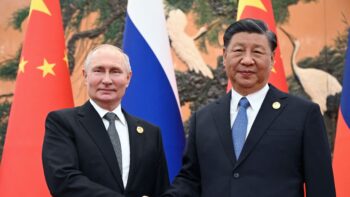
President Recep Tayyip Erdoğan at the presentation ceremony of the National Combat Aircraft KAAN on May 1, 2023 in Ankara, Türkiye.(Photo by Yavuz Ozden/ dia images via Getty Images )
BEIRUT — Turkey’s domestically built KAAN combat aircraft successfully completed its first flight today, a milestone that local industry and government were happy to trumpet.
The ability to produce an indigenous, advanced fighter has been a big push from Turkish President Recep Erdoğan, who has made nationalization of Turkey’s defense industry a key part of his leadership.
The fifth-generation aircraft, dubbed KAAN, “reached an altitude of 8,000 feet and achieved a speed of 230 knots,” Turkish Aerospace firm Tusas, which produces KAAN, claimed on its website. The flight lasted 13 minutes in total.
“It is a milestone without a doubt. KAAN is one of the few fifth-generation projects in the international weapons market,” Can Kasapoğlu, non-resident senior fellow at the Hudson Institute, told Breaking Defense. “Besides, Turkish defense planners have even more ambitious, ‘6th generation DNA’ plans about the aircraft, such as flying it with the loyal wingman concept alongside unmanned combat aircraft of Baykar and TUSAS, Kizilelma and ANKA-3, respectively.”
“The aircraft’s initial performance indicators are promising and balanced,” Kasapoğlu added.
“Its design philosophy has evolved since Turkey’s exodus from the F-35 consortium following the S-400 procurement. KAAN, formerly TF-X, was once planned to be an air-superiority asset. Now it is turning into a multirole aircraft,” Kasapoğlu said.
For KAAN, Kasapoğlu said, Turkey will need to be looking for export opportunities in order to keep the unit cost from “skyrocketing.” One early adaptor, at least on paper, has already put its hand up: In July 2023, during a national defense expo, Azerbaijan joined Turkey in its fifth-generation fighter jet program in a move described by Erdogan as a “new sign of solidarity between the two countries.”
While Kasapoğlu stressed the importance of KAAN as a large tactical aviation asset, he noted that it does not negate Turkey’s need for a fourth-generation fighter jet while the national asset becomes operational, saying “KAAN has a decade or so to go before manning the Turkish Air Force squadrons in meaningful numbers.”
As a result, Turkey is currently looking at two fourth-gen options. In November, Turkish Defense Minister Yasar Gular announced that Ankara is in talks to buy 40 Eurofighter Typhoons. And the US announced in late January that it is unfreezing a large deal of 40 new F-16 fighters to Turkey, after the country was expelled from the F-35 deal due to procuring the Russian S-400 Triumph air defense system.
Kasapoğlu predicts Turkey will focus on the F-16 buy as its priority, saying “The Eurofighter Typhoon, however, is a nice to have one — not a must. It remains to be seen if the Germans will be in business,” referencing Germany’s sometimes reluctance to allow exports of Typhoons around the globe.
Australia tops up Ukraine military aid with $100M
Australia has already supplied Ukraine with 120 Bushmaster vehicles, six 155mm howitzers, 56 M113 armored vehicles, 14 special operations vehicles and its signature cardboard drones.



























